
Unbroken tracts of forests connect soaring tropical glaciers in the center of the island to beautiful beaches ringing its coastline. Birds of Paradise, seen nowhere else on Earth except this region, inhabit these forests. So do hundreds of different tribes with entirely distinct languages, making this the most linguistically diverse area in the world.
The Huffington Post blog
September 2, 2016
Tom Dillon
Unbroken tracts of forests connect soaring tropical glaciers in the center of the island to beautiful beaches ringing its coastline. Birds of Paradise, seen nowhere else on Earth except this region, inhabit these forests. So do hundreds of different tribes with entirely distinct languages, making this the most linguistically diverse area in the world.
That’s what I experienced earlier this month when I traveled to Papua, a province of Indonesia just south of the equator. Rarely have I seen so much forestland in one region of the world. Forests blanket almost 80 percent of the province, which is nearly the size of Montana.
The province is committed to ensuring that forests continue to thrive at a large scale. It recently committed to at least 70 percent of the province remaining under forest cover for all time. It is an impressive commitment—one of the boldest in the world—and particularly needed when the rate of forest loss across the globe is equivalent to 48 football fields per minute.
It wouldn’t have happened if local community members throughout the province had not taken stock of their forests. Where are they located and how do people and wildlife use and benefit from them? What areas are important culturally and which for economic purposes? They learned — or, in some cases, reminded themselves—that trees hold soil in place so the rivers that are a source of drinking water for people remain clean. That trees absorb carbon. And provide shelter to thousands of species. Without these and other “services” from nature, neither people nor wildlife will survive. Once there was a clear picture of why nature matters, saving the forests of Papua became a no-brainer.
Taking stock of natural resources is part of a growing movement led by the Natural Capital Project. WWF and our partners who are part of the project recognize that in order to save ourselves, we need to maintain our living assets also known as “natural capital.”
We think of nature as a bank account. What is in it has value, which can be measured in terms of specific benefits, such as human health, economic development, food security and culture.
At the World Conservation Congress this month, WWF and others will talk about the exciting ways the results from natural capital assessments can be used. One way is to ensure areas of highest natural capital value are protected from the infrastructure tsunami that is heading our way. It is estimated that, over the next 15 years, $90 trillion could be invested in creating new roads, railways and other infrastructure, largely to meet the demands associated with an increasing population. Most of this would be in Africa, Asia and Central and South America. These countries also are home to much of the world’s most important biodiversity and forest lands.
See the full article, including the role the Margaret A. Cargill Foundation plays, on The Huffington Post blog, September 2, 2016
Photo Credit: © Minzayar Oo / WWF-US

